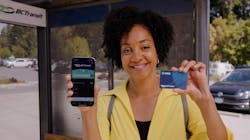BC Transit rolls out Umo digital fare payments in the Regional District of Nanaimo Transit System
BC Transit and the Regional District of Nanaimo have launched the Umo electronic fare system in the Regional District of Nanaimo Transit System.
Umo, owned and operated by Cubic Transportation Systems, introduces contactless payment methods and new fare products to the region that will improve the transit experience by allowing riders to pick the best options for their lifestyle and travel habits. Riders can now seamlessly travel on BC Transit’s interregional routes connecting Central Vancouver Island, Cowichan Valley and Southern Vancouver Island with one convenient payment method.
New payment methods include the Umo Mobility app and a reloadable Umo card. The Umo Mobility app is free in the Apple App and Google Play stores. Once downloaded, riders create an account to purchase and manage their fare products. When ready to travel, riders open their app to display a dynamic QR code that serves as their fare product. As riders board the bus, they present their app’s QR code to a new onboard digital validator.
The Umo app also provides riders with additional tools to help them plan their trip, including real-time information and maps. Riders looking to get the most out of their transit experience can also use the app to create alerts that will inform them when they are nearing their stop while travelling and if their fare product is running low on funds or nearing its expiration date.
Riders also have the choice of using a reloadable Umo card. A Umo card can be picked up for free from a BC Transit Umo vendor. The card is designed for continued use and can be continually topped up with fare products through a vendor, online or through Umo’s customer service call center..
At a future date, BC Transit plans to provincially enable onboard payments with debit and credit cards. These additional payment methods will provide wider access to transit perfect for riders who utilize transit services occasionally. Both debit and credit cards will benefit from the same fare-capping policy mobile app and reloadable card riders receive.
Umo’s arrival introduces changes and improvements to some of the fare products riders use with the introduction of the 30-Day Pass and Cash Balance fare products. The 30-Day Pass, eventually replacing the existing Monthly Pass, provides riders with the same convenience of having an unlimited long-term fare product, but introduces the flexibility of not having to wait until the start of a calendar month to use it.
The popular DayPASS fare product also sees improvements with Umo’s arrival through an increase in the number of ways riders can access it and by lowering a rider’s commitment to purchasing it. Riders paying with a Cash Balance fare product will have their fare capped and automatically converted to a DayPASS after payment on their second trip of the day. A rider will know a DayPASS has been applied to their payment method by referencing a confirmation message on the onboard validator’s digital screen.
BC Transit’s Electronic Fare Collection System Project to implement Umo across the province is funded through the Public Transit Infrastructure Stream of the Investing in Canada Infrastructure Program.
